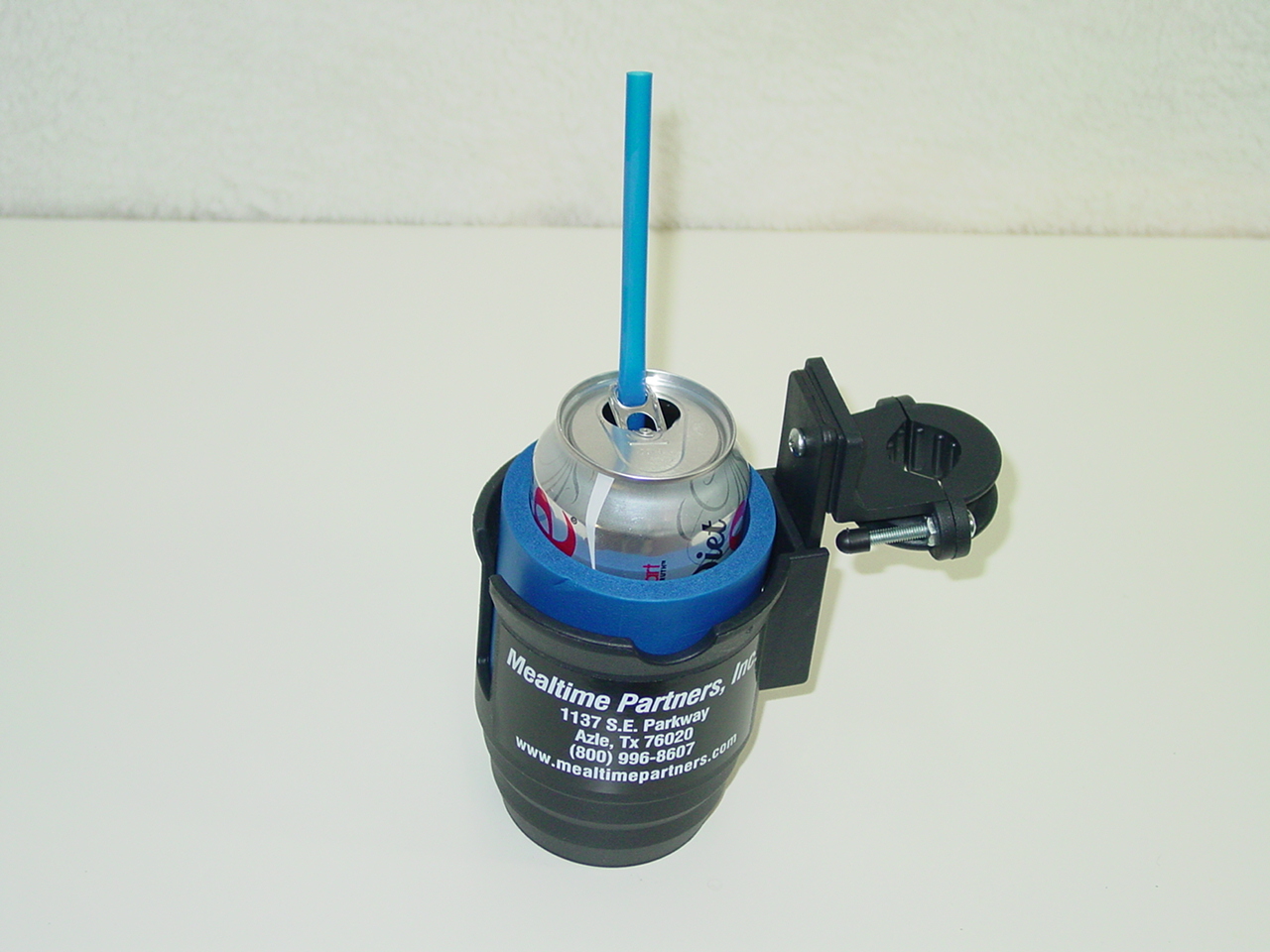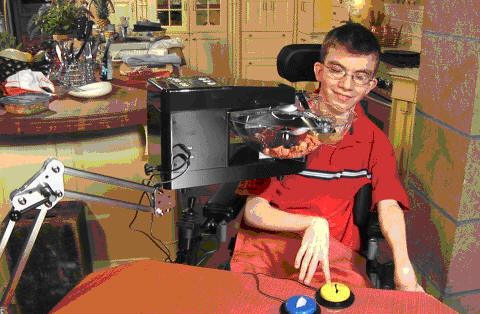Mealtime Partners, Inc.
Specializing in Assistive Dining and Drinking Equipment
February 2012 Independent Eating and Drinking Newsletter
 |
February Topics:
|
||
|
Mealtime Partners Home Page Send a Comment or Suggestion |
|||
Approximately 70% of our body weight is water that is in our cells, blood and the space between cells. Water is constantly lost from our body and must be replaced by drinking. We drink, we use the restroom, we perspire, etc. It is a constant cycle. However, the majority of people in the United States do not drink enough fluids.
Thirst is how our body indicates that the fluid in the body is out of balance (too low). Humans and animals have the innate ability to know when they should drink, however, many people regularly disregard the messages about drinking that their body sends them.
The problem of lack of fluids in more pronounced in the elderly. Many hospital visits for the elderly are because of dehydration and the estimated cost for hospitals stays for elders who were suffering from dehydration was estimated to be $1.36 billion in 1999. According to the “Malnutrition and Dehydration in Nursing Homes” report compiled by Burger, et al., the problem of dehydration for the elderly exists at epidemic proportions in the United States.
If dehydration is not treated it can have a very serious medical impact. The first signs of dehydration are a headache, dark yellow urine, reduced or lack of sweat, nausea and/or vomiting. Should dehydration worsen symptoms will escalate to altered mental status, fatigue, sleepiness and depression. If left untreated dehydration can be life threatening.
For more information on this topic please refer to the Mealtime Partners November 2009 Newsletter Topic: The Importance of Hydration.
The New and Improved Hydration Backpack with Drinking Tube Positioning
Because hydration is so important to good health, Mealtime Partners is emphasizing the use of hands-free drinking systems to facilitate consuming enough liquids for those who are unable to independently take a drink. In last months Newsletter the Front Mounted Drinking System was discussed. To continue providing details about our unique line of drinking products, this month we will describe the Hydration Backpack with Drinking Tube Positioning. Even though this product has been available for some time it was recently updated to include a larger bladder and longer tube positioning capability. Also, the new system has an on/off valve. These changes were made to facilitate the drinking system being accessible to a wider range of users with more diverse positioning and hydration needs. Figure 1 shows the Hydration Backpack with Tube Positioning mounted on a manual wheelchair.
|
|
| Figure 1 - The Hydration Backpack with Drinking Tube Positioning Attached to a Wheelchair |
The components of the Hydration Backpack with Drinking Tube Positioning are pictured in Figure 2. The backpack is an insulated canvas bag with shoulder straps and a carrying handle at the top. The canvas bag contains a 70-ounce bladder (20 ounces greater capacity than the previous product). A drinking tube extends from the base of the bladder and is enclosed in a slot in the shoulder strap of the backpack. At the end of the drinking tube is the bite valve assembly which contains an on/off valve and a bite valve. The opening in the bite valve opens to release liquid when it is pressed with lips or teeth.
 |
| Figure 2 - Components of the Hydration Backpack with Drink Tube Positioning |
The backpack can be mounted on the back of a wheelchair. If the wheelchair has handles the shoulder straps are looped over the handles and the backpack rests behind the seat and is relatively flat and unobtrusive (as shown in Figure 1). If the wheelchair does not have handles (like some power wheelchairs) the backpack can be attached to the wheelchair using the handle on the top of the bag and looping it over the Wheelchair Clamp once it is attached to the wheelchair frame. Additional mounting instructions for wheelchairs without handles, and for use with a bed, are included later in this article.
Once the backpack is in position, the Wheelchair clamp should be attached to one of the wheelchair handles. The Wheelchair Clamp has two clamping areas, a large clamping area for attaching to the Wheelchair structure and a smaller clamp to hold the Flex-tubing. Position the wider opening of the clamp around the Wheelchair handle with the screw knob positioned vertically so it won’t interfere with anything or prohibit mobility. Tighten the screw until the clamp is firmly attached to the handle as shown in Figures 3. (Needless to say, the clamp can be located on either side of the wheelchair to suit the preferences of the user.) The clamp should be positioned with the second, smaller clamp opening, on top of the handle. Loosen the thumb-screw on the top of the clamp until none of the threads are visible inside the clamp opening. Slide the Flex-tubing into the clamp opening from the front of the wheelchair to the back. After one link of the tubing is in the clamp, align the indent in the Flex-tubing with the thumb-screw and tighten it until the tubing is held firmly in place.
 |
| Figure 3 - Wheelchair Clamp Attached to Handle of a Wheelchair |
Flex tubing is easily formed into almost any number of straight or curved shapes. Form the Flex-tubing to come forward over the user’s shoulder, loop down towards their chest and then bend back upward, positioning the bite valve slightly below the user’s mouth as shown in Figure 4. Depending upon how much head, neck and trunk movement that the user has, the bite valve can be put very close to the user’s mouth or positioned to the side, or farther away.
 |
| Figure 4 - Flex-tube Positioned for User Access |
This drinking system is flexible enough that it can also be mounted to either a wheelchair with no handles, or to a bed. To mount the system on a wheelchair with no handle, attach the Wheelchair Clamp to a structural tube on the chair that is preferably at the user’s shoulder level. After the clamp is attached, slip the handle at the top of the backpack over the clamp making sure that it is securely positioned. When the backpack and clamp are in place, insert the Flex-tubing into the clamp as described above, and position the bite valve appropriately for the user. Similarly, the drinking system can be attached to the rail of a bed or a bed headboard. Thus liquids are available to a user all of the time.
It should be noted that once the Flex-tubing is formed into position it will hold its position until it is adjusted. However, should the user move forward and strike the tube, it will not resist the force and will move with the user. The tubing has no sharp edges and moves fluidly, and this provides a safety mechanism for all users.
It is recommended that this system be used primarily to provide water to the user, rather than juices, cola’s, or sports drinks. This is because it is a more complex system to clean than a cup or mug that would be used in the Mealtime Partners Front Mounted Drinking System. The bladder, tubing and bite-valve need very thorough cleaning to prevent the growth of bacteria in the bladder and drinking tube. It will require more frequent cleaning if anything other than water is put into the drinking system. Detailed instructions for cleaning the Hydration Backpack with Drinking Tube Positioning are provided with each drinking system.
Follow this link to purchase a Hydration Backpack with Drinking Tube Positioning. If you have additional questions about the Hydration Backpack with Drinking Tube Positioning, please email Mealtime Partners at questions about drinking systems, or call us at 800-996-8607. We will be happy to discuss whether this drinking system will be able to meet the needs of a specific user.
|
Did You Know?
Did you know that you can stop a straw from floating by
using the tab on a can after the can is opened? Have you
ever noticed that if you put a straw into can of soda that
it floats? This isn’t a problem if you are able to hold it
in place while you take a drink but is a problem for those
who are unable to use their hands to hold and position a
straw. To hold a straw in a can of soda, bend the tab that is used to open the can over the open hole of the can. Slot the straw through the hole in the tab. This provides a snug fit for the straw and once the straw is inserted through the hole, it will remain in place. Rotate the can to position the straw so that the user can drink from the straw without significant head movement. (See picture below.) |
 |
| Straw held in place by the Can's tab. |
| The Mealtime Partner Dining System | |
 |
|
|
The Mealtime Partner Dining System can be positioned to meet the specific
needs of each user. The user does not have to adjust their
position to eat using the device because the Partner’s flexible
mounting systems permit positioning to fit the user's needs,
making mealtimes a
comfortable, relaxed experience, with the user positioned safely
for eating. The Mealtime Partner empowers its user to eat what they want, when they want it. The Mealtime Partner Dining System is quick and easy to learn and has no complicated programming requirements. Each Dining System comes with a complete training video on DVD so new users and caregivers can learn to use it in just a few minutes. For more information about the Mealtime Partner Dining System, please visit Mealtime Partners website. There is no other assistive dining system that meets the needs of the users, like the Mealtime Partner. |
Mealtime Partners Website Navigation:
Home | Dining | Drinking | Videos | All Products | Warranty | Ordering | Calendar | FAQ | Newsletters | Contact
Please send comments and suggestions to newsletters@mealtimepartners.com
Copyright © Mealtime Partners, Inc. 2012
All rights reserved.